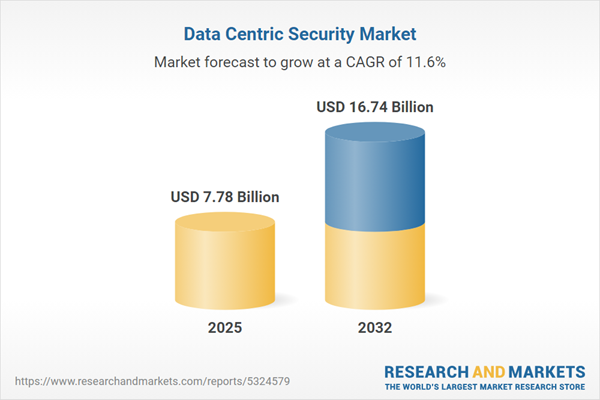Speak directly to the analyst to clarify any post sales queries you may have.
Data centric security is increasingly recognized as an essential framework for organizations facing dynamic compliance demands and sophisticated digital threats. Senior decision-makers are prioritizing this approach to align investments with evolving operational environments and regulatory obligations.
Market Snapshot: Data Centric Security Market Size and Growth
The data centric security market is advancing rapidly as businesses place greater emphasis on digital resiliency and regulatory compliance. As of 2024, the global market is valued at USD 6.97 billion and is projected to reach USD 7.78 billion by 2025, with consistent expansion anticipated. This growth is driven by the integration of unified security platforms, which combine advanced encryption, automated governance processes, and incident response capabilities. Organizations are leveraging these solutions to adapt to shifting regulatory landscapes, protect confidential data, and manage distributed IT infrastructures in both cloud and on-premises environments. The adoption of such platforms is streamlining security oversight, allowing companies to efficiently fortify sensitive data and enhance overall compliance postures.
Scope & Segmentation of the Data Centric Security Market
For executive leaders, segmenting the data centric security market is key to aligning technology decisions with unique business objectives and meeting local as well as global compliance requirements.
- Components: Consulting, integration, and maintenance services are central to effective deployment of encryption, continuous monitoring, data loss prevention, and masking technologies, all crucial for sustained compliance and threat resilience.
- Deployment Modes: Options between cloud-based and on-premises models enable modernization of legacy systems and allow organizations to tailor security solutions to sector-specific operational and compliance needs.
- Organization Sizes: Large enterprises, as well as small and medium-sized businesses, benefit from solution customizations that reflect differing digital maturity and risk tolerance.
- End User Industries: Leading sectors such as finance, government, healthcare, manufacturing, retail, and eCommerce all deploy data centric security for purposes including transaction protection, privacy management, intellectual property safeguarding, and supply chain integrity.
- Regional Coverage: Providers adjust their solutions to align with compliance and threat patterns relevant to the Americas, Europe, Middle East, Africa, and Asia-Pacific. This enables better fit for regional regulatory requirements and technology adoption preferences.
- Key Companies Profiled: Industry leaders featured include Broadcom Inc., Forcepoint LLC, McAfee LLC, Digital Guardian, Check Point Software Technologies Ltd, Trend Micro Inc., IBM Corporation, Informatica LLC, Varonis Systems, and PKWARE, each supporting comprehensive strategic analysis.
Key Takeaways: Data Centric Security Market Insights
- The industry is moving away from relying solely on network perimeters, focusing instead on robust safeguards at the data layer for greater flexibility in remote and hybrid environments.
- Modern governance models are increasing enterprise agility and are built to address the nuances of international data privacy regulations.
- Unified platforms enable organizations to consolidate oversight, extend protection across diverse application ecosystems, and bridge legacy systems with modern technologies.
- Automated and AI-powered analytics are becoming key to identifying threats quickly and minimizing manual response times, thus supporting compliance initiatives more effectively.
- Deployment strategies are increasingly tailored to the priorities of each sector, allowing organizations in finance, healthcare, government, and industry to implement distinct data protection policies and operational controls.
Tariff Impact: Navigating Procurement and Supply Chain Shifts
Upcoming U.S. tariffs in 2025 are prompting organizations to review procurement strategies and accelerate adoption of cloud-based encryption and Security-as-a-Service models. These shifts are particularly pronounced among highly regulated sectors and public entities, where maintaining budget certainty and seamless delivery of key security services takes precedence amid evolving geopolitical considerations.
Methodology & Data Sources
This analysis draws from direct stakeholder interviews, detailed expert assessments, and verified secondary research. Findings are rigorously cross-checked against the latest regulatory frameworks and industry developments to ensure actionable guidance for executive-level planning.
Why This Report Matters
- Enables executives to steer cybersecurity investments toward stronger risk mitigation and greater regulatory confidence.
- Provides clear benchmarking and practical recommendations to help companies refine procurement strategies and strengthen technology partnerships for long-term value.
- Delivers market and regional insights designed to support the implementation of security strategies that stay current and operationally relevant amid changing compliance demands.
Conclusion
Shifting to a data centric security model is now critical for ongoing digital transformation and future compliance. These insights empower leaders to build agile, resilient security programs that address risks in an ever-changing threat landscape.
Additional Product Information:
- Purchase of this report includes 1 year online access with quarterly updates.
- This report can be updated on request. Please contact our Customer Experience team using the Ask a Question widget on our website.
Table of Contents
3. Executive Summary
4. Market Overview
7. Cumulative Impact of Artificial Intelligence 2025
List of Figures
Companies Mentioned
The companies profiled in this Data Centric Security market report include:- Broadcom Inc.
- Forcepoint LLC
- McAfee LLC
- Digital Guardian, Inc.
- Check Point Software Technologies Ltd
- Trend Micro Inc.
- IBM Corporation
- Informatica LLC
- Varonis Systems, Inc.
- PKWARE, Inc.
Table Information
| Report Attribute | Details |
|---|---|
| No. of Pages | 191 |
| Published | November 2025 |
| Forecast Period | 2025 - 2032 |
| Estimated Market Value ( USD | $ 7.78 Billion |
| Forecasted Market Value ( USD | $ 16.74 Billion |
| Compound Annual Growth Rate | 11.5% |
| Regions Covered | Global |
| No. of Companies Mentioned | 11 |









